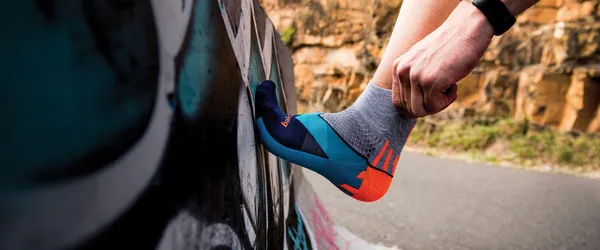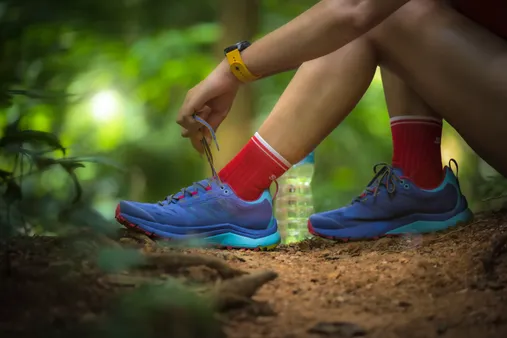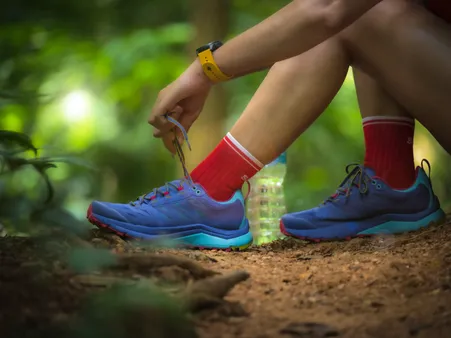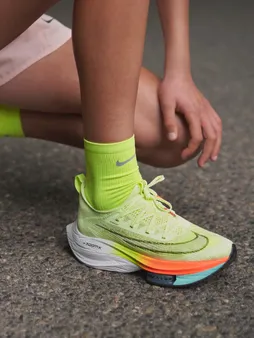Table of Contents
Are you a passionate runner seeking the ultimate footwear and hosiery combination to elevate your running experience? Look no further than Kizworld, your trusted source for comprehensive running gear guidance. In this extensive guide, we'll help you navigate the world of running shoes and socks, ensuring you find the perfect pair to keep your feet comfortable, protected, and performing at their best. From understanding key features to consider when selecting running shoes and socks to discovering the best options for different types of runners, we've got you covered. Get ready to embark on a journey towards running excellence, starting with the foundation of your running attire – The best running shoes and socks.
The Best Running Shoes and Socks: Elevate Your Running Experience
I. Running Shoes and Socks: Improving Your Performance
Running Shoes and Socks: Improving Your Performance
The Right Fit
The most important factor to consider when choosing running shoes is the fit. Your shoes should fit snugly but not too tightly, and they should provide good support for your feet. If your shoes are too loose, they can cause blisters and other injuries. If they're too tight, they can restrict blood flow and cause pain.
- Measure your feet before you buy running shoes.
- Try on shoes in the afternoon, when your feet are slightly swollen.
- Wear the shoes for a few minutes to make sure they feel comfortable.
- Make sure there is about a thumb's width of space between your longest toe and the end of the shoe.
Cushioning
Running shoes come with different levels of cushioning. If you're a new runner, you may want to choose a shoe with more cushioning to help absorb shock and protect your feet. As you get more experienced, you may prefer a shoe with less cushioning for better responsiveness.
Cushioning Level | Description |
High | Provides the most shock absorption and protection. |
Medium | Provides a balance of shock absorption and responsiveness. |
Low | Provides the least shock absorption and the most responsiveness. |
Support
Running shoes also come with different levels of support. If you have flat feet or overpronate (your feet roll inward when you run), you may need a shoe with more support. If you have high arches or underpronate (your feet roll outward when you run), you may need a shoe with less support.
Support Level | Description |
High | Provides the most support for feet that overpronate. |
Medium | Provides a balance of support and flexibility. |
Low | Provides the least support for feet that underpronate. |
Other Considerations
In addition to fit, cushioning, and support, there are a few other factors to consider when choosing running shoes:
- Weight: Lighter shoes are generally more responsive and easier to run in.
- Breathability: Shoes with good breathability will help keep your feet cool and dry.
- Durability: Running shoes should be durable enough to withstand the rigors of running.
- Price: Running shoes can range in price from $50 to $200. It's important to find a shoe that fits your budget.
Running Socks
Running socks are also an important part of your running gear. They can help to wick away sweat, prevent blisters, and provide cushioning for your feet. When choosing running socks, look for socks that are made from a moisture-wicking material, such as polyester or nylon. You should also choose socks that fit snugly but not too tightly.
By following these tips, you can choose the best running shoes and socks for your individual needs. With the right gear, you'll be able to run more comfortably and enjoy your runs more.
If you're new to running, it's a good idea to talk to a running coach or experienced runner before you buy your first pair of running shoes. They can help you assess your needs and choose the right shoes for you.
Once you have the right running shoes and socks, you're ready to hit the pavement and start running! Just remember to start slowly and gradually increase your mileage over time. And most importantly, have fun!
Here are some additional tips for choosing the best running shoes and socks:
- Consider your running style. If you're a heel striker, you'll need a shoe with more cushioning in the heel. If you're a midfoot striker, you'll need a shoe with more cushioning in the midfoot. And if you're a forefoot striker, you'll need a shoe with more cushioning in the forefoot.
- Think about the terrain you'll be running on. If you'll be running on pavement, you'll need a shoe with less cushioning than if you'll be running on trails.
- Don't be afraid to try on different shoes. The best way to find the right running shoe for you is to try on different pairs and see which ones feel the most comfortable.
With a little research, you can find the best running shoes and socks for your individual needs. So get out there and start running!
Related posts: How to Choose the Right Running Shoes and Socks, The Best Running Shoes and Socks, How to Care for Your Running Shoes and Socks
II. Types of Running Shoes
Types of Running Shoes
Neutral Shoes
- Best for runners with normal arches and no pronation issues.
- Provide good cushioning and support.
- Examples: Brooks Ghost, Nike Pegasus, Saucony Triumph.
Stability Shoes
- Designed for runners with mild to moderate overpronation.
- Offer more support and stability than neutral shoes.
- Examples: Asics Kayano, Mizuno Wave Inspire, New Balance 860.
Motion Control Shoes
- For runners with severe overpronation or other foot problems.
- Provide the most support and stability.
- Examples: Brooks Beast, Saucony Hurricane, Asics Gel-Kayano 27.
Trail Running Shoes
- Designed for running on off-road surfaces.
- Have a more aggressive tread pattern for better traction.
- Often have a rock plate to protect the foot from sharp objects.
Racing Shoes
- Designed for speed and performance.
- Are lightweight and have a薄底 design.
- Examples: Nike Zoom Fly, Adidas Adizero Adios Pro, Saucony Endorphin Pro.
When choosing a running shoe, it's important to consider your foot type, running style, and the surfaces you'll be running on. You should also try on several different pairs of shoes to find the one that fits best and feels most comfortable.
III. Best Running Socks
In addition to finding the right running shoes, it's also important to choose the right running socks. Socks that are too thick or too thin can cause blisters and other foot problems. Look for socks that are made from moisture-wicking fabric to keep your feet dry and comfortable.
- Balega Blister Resist No-Show Socks: These socks are made with a unique double-layer design that helps to prevent blisters.
- Darn Tough Vermont Vertex Ultralight Running Socks: These socks are made from merino wool, which is naturally moisture-wicking and odor-resistant.
- Feetures Elite Max Cushion No-Show Tab Socks: These socks have a cushioned sole for added comfort.
No matter what type of running you do, it's important to have the right shoes and socks to help you perform your best. With so many different options available, you're sure to find the perfect pair of running shoes and socks for your needs.
Read more about the best running shoes and socks
IV. Choosing the Right Socks
Choosing the Right Socks
Running socks are not all created equal. Some are designed for specific types of running, while others are better suited for different weather conditions. When choosing running socks, it's important to consider the following factors:
- Cushioning: Running socks should provide cushioning to protect your feet from impact. This is especially important if you're running on hard surfaces, such as concrete or asphalt.
- Wicking: Running socks should wick away sweat to keep your feet dry and comfortable. This can help prevent blisters and other foot problems.
- Fit: Running socks should fit snugly to prevent them from bunching up or slipping. However, they should not be too tight, as this can restrict blood flow to your feet.
- Material: Running socks are typically made from synthetic materials, such as nylon or polyester. It's important to choose socks that are made from a breathable material so that your feet can stay cool and dry.
- Thickness: Running socks come in a variety of thicknesses. Thicker socks provide more cushioning, while thinner socks are more breathable.
Once you've considered these factors, you can start shopping for running socks. Here are a few of our top picks:
- The Best Running Socks for Men
- The Best Running Socks for Women
- The Best Running Socks for Winter
- The Best Running Socks for Summer
- The Best Running Socks for Trail Running
Feature | Cotton socks | Synthetic socks | Wool socks |
Cushioning | Low | High | Medium |
Wicking | Poor | Good | Excellent |
Fit | Loose | Snug | Snug |
Material | Cotton | Nylon, polyester | Wool |
Thickness | Thick | Thin | Medium |
No matter what type of running you do, it's important to wear the right socks. By following these tips, you can find the perfect pair of running socks to help you stay comfortable and focused on your run.
V. Caring for Your Running Shoes and Socks
Caring for Your Running Shoes and Socks
Keep Your Running Shoes Clean
- Wipe down your shoes with a damp cloth after each run.
- If your shoes are really dirty, you can wash them in the washing machine on a gentle cycle.
- Be sure to air dry your shoes completely before wearing them again.
Related: How to Choose the Right Running Shoes and Socks
Store Your Running Shoes Properly
- Store your running shoes in a cool, dry place.
- Avoid storing your shoes in direct sunlight or in a hot car.
- If you're not going to be using your running shoes for a while, stuff them with newspaper to help them keep their shape.
Related: The Best Running Shoes and Socks
Replace Your Running Shoes Regularly
- Running shoes should be replaced every 300 to 500 miles.
- If you're a heavy runner, you may need to replace your shoes more often.
- You can tell when your running shoes need to be replaced by looking for signs of wear and tear, such as worn-down soles or cracked uppers.
Related: How to Care for Your Running Shoes and Socks
Wash Your Running Socks Regularly
- Wash your running socks after each run.
- You can wash your running socks in the washing machine on a gentle cycle.
- Be sure to air dry your running socks completely before wearing them again.
Related: The Best Running Socks for Different Types of Runners
Choose the Right Running Socks
- Choose running socks that are made from a moisture-wicking material.
- Avoid wearing cotton socks, as they can absorb sweat and make your feet feel wet and uncomfortable.
- You may also want to consider wearing compression socks, which can help to improve blood circulation and reduce swelling in your feet.
Related: How to Choose the Right Running Shoes and Socks
Prevent Common Running Injuries
- Warm up before you start running.
- Cool down after you finish running.
- Stretch your muscles regularly.
- Wear the right shoes and socks.
- Listen to your body and take breaks when you need them.
Related: Common Running Injuries and How to Prevent Them
VI. Conclusion
Choosing the right running shoes and socks is essential for a comfortable and enjoyable running experience. By following the tips in this guide, you can find the perfect footwear and hosiery for your individual needs. Remember to consider your foot type, running style, and the terrain you'll be running on. With the right shoes and socks, you'll be able to run longer, faster, and more comfortably. So what are you waiting for? Get out there and start running!